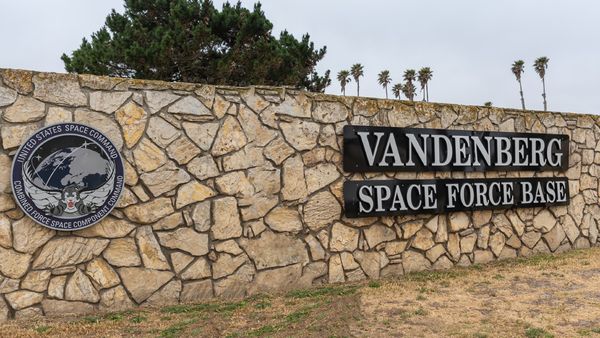Former army pilot Jim Miles has discovered a number of underwater plane and shipwrecks in his time but finding the final resting place of WWII bomber A72-80 was different.
The plane is submerged in silty waters off one of the most remote sections of the Kimberley coastline where crocodiles are king and strong tides rip through.
But the challenges didn't deter Mr Miles, who said he'd been waiting 10 years to make it back to the wreck site after his first expedition there in 2009.
"I really wanted to get some decent video footage [this time]," Mr Miles said.
The video he took during his latest expedition in May is the first public glimpse of the decaying B24 bomber since it crashed.
Mr Miles said descending through to the murky depths and seeing the downed aircraft with its tyres still intact was an almost "spiritual" moment.
The ditching of A72-80
Twelve airmen died aboard A72-80 when it crashed near Truscott Airfield, a top secret base for Royal Australian Airforce missions during World War II.
The B-24 Liberator had just taken off for a bombing run over parts of Indonesia on March 23, 1945, when it crashed just kilometres from the runway.
Only three bodies were recovered from the plane.
The rescue mission was hampered by the same dangers that Mr Miles faced: crocs, tides and sharks.
An air force Court of Inquiry was established in the days after the crash to investigate what happened but was unable to determine the reason why A72-80 went down.
One document investigators referenced was a photo taken the day of the ditching, which showed black plumes of smoke ominously rising from waters near Truscott.
The same photo was given to Mr Miles by archaeologist Silvano Jung after the pair collaborated on another mission to find lost WWII steamer SS Florence D.
"Dr Silvano Jung sat me down for a coffee in Darwin … and flopped a black and white photograph in front of me of a burning wreck on the ocean," Mr Miles said.
Using the photo and some dive gear, Mr Miles found A72-80 and confirmed the wreck by identifying a square piece of metal at the back of the plane's engine.
"Beautifully on the wreck there it is, this little square rectangle of metal which is exactly the same as any photograph," Mr Miles said.
Leather briefcase reveals last moments
For David Hursthouse, whose father John Hursthouse was on the plane when it crashed, the moments captured in the photo defined the rest of his life.
Now in his 70s, Mr Hursthouse was only six months old when his dad died.
He said his mother never really spoke to him about what had happened.
"You know, as you get older, you start thinking back," he said.
"And because I had no father figure to follow, I became a bit [of a] gypsy.
"I missed him, or I missed a strong leadership ... a father figure."
It wasn't until his mother died in 2002 that he found a leather briefcase containing letters and documents about the crash.
He started to unravel the mystery of the accident.
He said a telegram in the suitcase made him wonder how his mum would have taken the news and could explain why she never talked about it.
"It [the telegram] said basically, further body sighted on remote beach," he said.
"But when land party arrived, all they found was a shirt named JW Hursthouse and evidence that the body had been removed into the sea by a crocodile."
After reading the telegram, Mr Hursthouse said he wanted to go to Truscott Airbase and "shoot a crocodile in revenge".
That didn't happen, but Mr Hursthouse did eventually visit the remote airstrip where he scattered a portion of his mothers ashes.
"Mum's atoms and my fathers atoms are sort of mingling there somewhere," he said.
Airforce grapples with missing personnel
Royal Australian Air Force Historic Unrecovered War Casualties unit leader Grant Kelly said the air force was aware of the location of the wreck.
But in order to recover planes lost during WWII such as A72-80, the air force would need to essentially conduct an archaeological dig underwater.
"That's an incredible amount of resources and depending on the site can be an incredible amount of risk as well," Group Captain Kelly said.
He said more than 3,000 airmen from WWII had no known grave and about 1,500 aircraft were still considered missing.
"We have thousands, as I said, of crashed aircraft," Mr Kelly said.
"We believe the best way that individual commemorations can be made is using history associations, squadrons or aircraft associations or RSLs, or families that can look after these memorials, and be involved with the dedication of them."
Memorial at Truscott Airbase
A memorial to those lost aboard A72-80 already exists at the Adelaide River War Cemetery.
But Mr Hursthouse said there were memorials to other crashed aircraft at Truscott when he visited, but not A72-80.
He felt his father's plane had been "forgotten".
"Even now as I say there's not even a grave to go to, so as far as that goes you just sort of end up with this psychological empty bit in your life," Mr Hursthouse said.
He said he hoped a plaque for A72-80 would be placed at the airfield which now served as a base servicing offshore resources facilities in the Timor Sea.
He said he'd be more than happy to help and just so happened to be working there flying helicopters.
He said he had the perfect spot marked out.
"There's a piece of land only 1km away from the wreck site which looks out over the bay, Vansittart Bay, which is ideally placed to memorialise the wreck and those lost in it," he said.
"I can walk there through the bush and with a backpack of concrete and use some local stone to erect a nice plaque in memorial of those guys, for the family."







